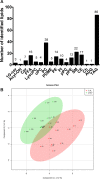Lipidomic Analysis Reveals Serum Alteration of Plasmalogens in Patients Infected With ZIKA Virus
- PMID: 31031729
- PMCID: PMC6474330
- DOI: 10.3389/fmicb.2019.00753
Lipidomic Analysis Reveals Serum Alteration of Plasmalogens in Patients Infected With ZIKA Virus
Abstract
Zika virus (ZIKV) is an arthropod-borne virus (arbovirus) in the Flavivirus genus of the Flaviviridae family. Since the large outbreaks in French Polynesia in 2013-2014 and in Brazil in 2015, ZIKV has been considered a new public health threat. Similar to other related flavivirus, ZIKV is associated with mild and self-limiting symptoms such as rash, pruritus, prostration, headache, arthralgia, myalgia, conjunctivitis, lower back pain and, when present, a short-term low grade fever. In addition, ZIKV has been implicated in neurological complications such as neonatal microcephaly and Guillain-Barré syndrome in adults. Herein, serum lipidomic analysis was used to identify possible alterations in lipid metabolism triggered by ZIKV infection. Patients who presented virus-like symptoms such as fever, arthralgia, headache, exanthema, myalgia and pruritus were selected as the control group. Our study reveals increased levels of several phosphatidylethanolamine (PE) lipid species in the serum of ZIKV patients, the majority of them plasmenyl-phosphatidylethanolamine (pPE) (or plasmalogens) linked to polyunsaturated fatty acids. Constituting up to 20% of total phospholipids in humans, plasmalogens linked to polyunsaturated fatty acids are particularly enriched in neural membranes of the brain. The biosynthesis of plasmalogens requires functional peroxisomes, which are important sites for viral replication, including ZIKV. Thus, increased levels of plasmalogens in serum of ZIKV infected subjects suggest a link between ZIKV life cycle and peroxisomes. Our data provide important insights into specific host cellular lipids that are likely associated with ZIKV replication and may serve as platform for antiviral strategy against ZIKV.
Keywords: Zika virus; arbovirus; phosphatidylethanolamine; plasmalogens; serum lipidomics.
Figures




Similar articles
-
Zika virus as an emerging arbovirus of international public health concern.Osong Public Health Res Perspect. 2022 Oct;13(5):341-351. doi: 10.24171/j.phrp.2022.0101. Epub 2022 Oct 12. Osong Public Health Res Perspect. 2022. PMID: 36328238 Free PMC article.
-
Zika virus: A new threat to human reproduction.Am J Reprod Immunol. 2017 Feb;77(2). doi: 10.1111/aji.12614. Epub 2016 Dec 14. Am J Reprod Immunol. 2017. PMID: 27966802 Review.
-
[The Recent Epidemic Spread of Zika Virus Disease].Uirusu. 2018;68(1):1-12. doi: 10.2222/jsv.68.1. Uirusu. 2018. PMID: 31105130 Review. Japanese.
-
Emergence of Zika virus.Virologie (Montrouge). 2015 Oct 1;19(5):225-235. doi: 10.1684/vir.2015.0622. Virologie (Montrouge). 2015. PMID: 32260029 English.
-
Flavonoids as Molecules With Anti-Zika virus Activity.Front Microbiol. 2021 Sep 10;12:710359. doi: 10.3389/fmicb.2021.710359. eCollection 2021. Front Microbiol. 2021. PMID: 34566915 Free PMC article. Review.
Cited by
-
Characterization of the lipidomic profile of BmN cells in response to Bombyx mori cytoplasmic polyhedrosis virus infection.Dev Comp Immunol. 2021 Jan;114:103822. doi: 10.1016/j.dci.2020.103822. Epub 2020 Aug 15. Dev Comp Immunol. 2021. PMID: 32810558 Free PMC article.
-
AGMO Inhibitor Reduces 3T3-L1 Adipogenesis.Cells. 2021 May 1;10(5):1081. doi: 10.3390/cells10051081. Cells. 2021. PMID: 34062826 Free PMC article.
-
Coronavirus-Induced Host Cubic Membranes and Lipid-Related Antiviral Therapies: A Focus on Bioactive Plasmalogens.Front Cell Dev Biol. 2021 Mar 12;9:630242. doi: 10.3389/fcell.2021.630242. eCollection 2021. Front Cell Dev Biol. 2021. PMID: 33791293 Free PMC article. Review.
-
Lipid Droplets and Their Participation in Zika Virus Infection.Int J Mol Sci. 2022 Oct 20;23(20):12584. doi: 10.3390/ijms232012584. Int J Mol Sci. 2022. PMID: 36293437 Free PMC article. Review.
-
Peroxisomes and Viruses: Overview on Current Knowledge and Experimental Approaches.Methods Mol Biol. 2023;2643:271-294. doi: 10.1007/978-1-0716-3048-8_19. Methods Mol Biol. 2023. PMID: 36952192 Review.
References
LinkOut - more resources
Full Text Sources

